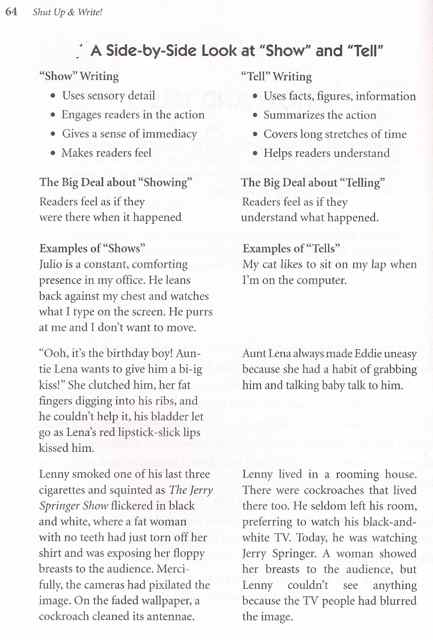Shut Up & Write
Warning: If you're not into writing, this post might not interest you. But there's a kitty. . . .
A few months ago, I received a copy of Judy Bridges' book, Shut Up & Write, published by Redbird Studio Press in January 2011. I recently finished reading it and enjoyed it very much.
Shut Up & Write would be very helpful for someone who is just beginning to write for publication (either fiction or non-fiction) and needs encouragement or direction. However, it is also interesting—and helpful—for someone who has been writing for a while. A list of the chapters is here.
One thing I especially like is that Bridges not only defines terms, she also provides examples. The difference between showing and telling is sometimes confusing to new writers, but Bridges explains differences between show and tell in an easy-to-understand way (page 64):
Another thing I like is that she provides some alternatives to the traditional outline. While I like knowing where my story is going, I hate formal outlines. Her "bubble outline" and her "alligator outline" are more visual, and they're handy for both fiction and non-fiction. I especially liked the alligator outline and will probably use this technique in the future.
Folks sometimes ask me what books I recommend for aspiring writers. I've just added Shut Up & Write to my list. Should you want to make your writing more effective—and more publishable—here's my choice of the top five books you should read, preferably in this order :
Begin with Bridges' book. Then read Lynn Price's The Writer's Essential Tacklebox, followed by Constance Hale's Sin and Syntax, then Les Edgerton's Hooked, and finally Noah Lukeman's The First Five Pages.
These five books are all readable, entertaining, and helpful. And they've all received a cat scan of approval from Chloe.
A few months ago, I received a copy of Judy Bridges' book, Shut Up & Write, published by Redbird Studio Press in January 2011. I recently finished reading it and enjoyed it very much.
Shut Up & Write would be very helpful for someone who is just beginning to write for publication (either fiction or non-fiction) and needs encouragement or direction. However, it is also interesting—and helpful—for someone who has been writing for a while. A list of the chapters is here.
One thing I especially like is that Bridges not only defines terms, she also provides examples. The difference between showing and telling is sometimes confusing to new writers, but Bridges explains differences between show and tell in an easy-to-understand way (page 64):
Here's what the alligator outline looks like for a non-fiction article:
I'm a believer in writers groups, and I like that Bridges addressed the reasons for joining a critique group and explained how to find the right one. I also like her "character wheel" approach to fleshing out characters.
Shut Up & Write has been favorably reviewed on several writers' blogs. You might want to take a look at this one or this one.
Folks sometimes ask me what books I recommend for aspiring writers. I've just added Shut Up & Write to my list. Should you want to make your writing more effective—and more publishable—here's my choice of the top five books you should read, preferably in this order :
Begin with Bridges' book. Then read Lynn Price's The Writer's Essential Tacklebox, followed by Constance Hale's Sin and Syntax, then Les Edgerton's Hooked, and finally Noah Lukeman's The First Five Pages.
These five books are all readable, entertaining, and helpful. And they've all received a cat scan of approval from Chloe.
~
Labels: reading. writing








3 Comments:
Examples are the best way to get something into my head.
Thank you for sharing - this is wonderful!
Oh, I have this book in my to-read pile. I will have to move it toward the front! Thanks for the heads up!
Post a Comment
<< Home